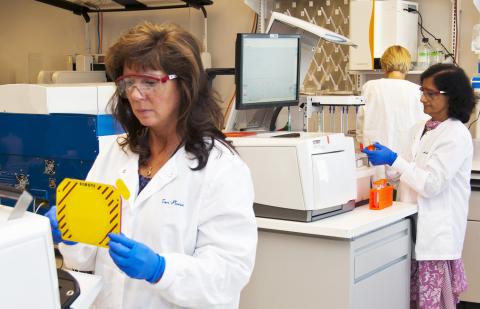
Teri Plona places a protective shield on the Roche 454. Arati Raziuddin and Viktoriya Grinberg prepare samples in the background.
By Ashley DeVine, Staff Writer
By the end of October, the Advanced Technology Research Facility (ATRF) will be one of the few facilities in the world to house all of the latest DNA sequencing technologies.
“Sequencing costs have decreased more than 10,000-fold, which now enables broader surveys of cancer genomes,” said Dan Soppet, Ph.D., director of the Laboratory of Molecular Technology (LMT), Advanced Technology Program. “With the ability to study thousands of cancer genomes at increasing resolution, we can now identify all of the commonly seen mutations in cancer genes and many of the rare genetic changes that may contribute in combination to the establishment and progression of cancer.”
Next-generation sequencing has reduced DNA sequencing time from months to days or even hours.
Five Next-Generation Sequencers in One Location
Next-generation sequencers available in LMT include the Roche 454, Life Technologies SOLiD 5500 XL, and Life Technologies Ion Torrent Personal Genome Machine.
The Sequencing Facility (SF), which will move to the ATRF in October, offers sequencing on the Illumina HiSeq2000 and GAIIx and the Pacific Biosciences PacBio RS.
“Different sequencers have different strengths and weaknesses and are appropriate for answering different types of cancer questions,” said Jennifer Troyer, Ph.D., senior scientist, Technology Development, LMT. “Often one sample or set of samples will be run on more than one sequencing platform.”
The 454’s moderate throughput but relatively long reads of 400–1,000 base pairs (bp) work well for whole-genome sequencing of small or medium genomes. For example, a bacterial genome is considered relatively small because it may have a few million base pairs of DNA compared to the three billion in the human genome.
One of the advantages of the PacBio RS (3,400-bp read) is that, although it produces less data, it can sequence difficult regions of a genome that have not been sequenced well by other machines. The PacBio RS also does not require fragment DNA to be amplified or cloned, which can result in biases.
On the other hand, systems like the SOLiD or Illumina HiSeq, which have shorter reads, are better suited to sequencing large genomes because they have a much higher sequencing capacity. They also perform well for DNA–protein interaction studies and transcriptome profiling.
The Illumina and PacBio platforms “can be used together quite effectively, particularly for de novo assembly of whole genomes,” said Bao Tran, Ph.D., director of SF.
The Ion Torrent, which LMT acquired last year through an early access program, offers price and speed advantages over other sequencers. A sequence run can cost as little as $500 to $750 (at around $20 per megabase pair [Mbp]), compared to typical prices of $1,500–$7,500 (at less than $1 per Mbp) for the Illumina, Roche, or SOLiD sequencers. An Mbp measures how much sequence data is produced in a single run.
LMT is working towards Clinical Laboratory Improvement Amendment (CLIA) certification on the Ion Torrent so it can be used to sequence patient samples.
Sanger Sequencers Are Important for Clinical Studies
LMT also has two ABI 3730XL conventional Sanger sequencing instruments that are CLIA-certified, making them important for use in clinical studies. “These are crucial to the validation of next-generation sequencing experiments, while maintaining an important core sequencing service and CLIA-validated mutation detection to NCI investigators,” said Kristen Pike, group leader, CLIA Molecular Diagnostics Sanger Sequencing Group and Roche 454 Next-Generation Sequencing Group.

